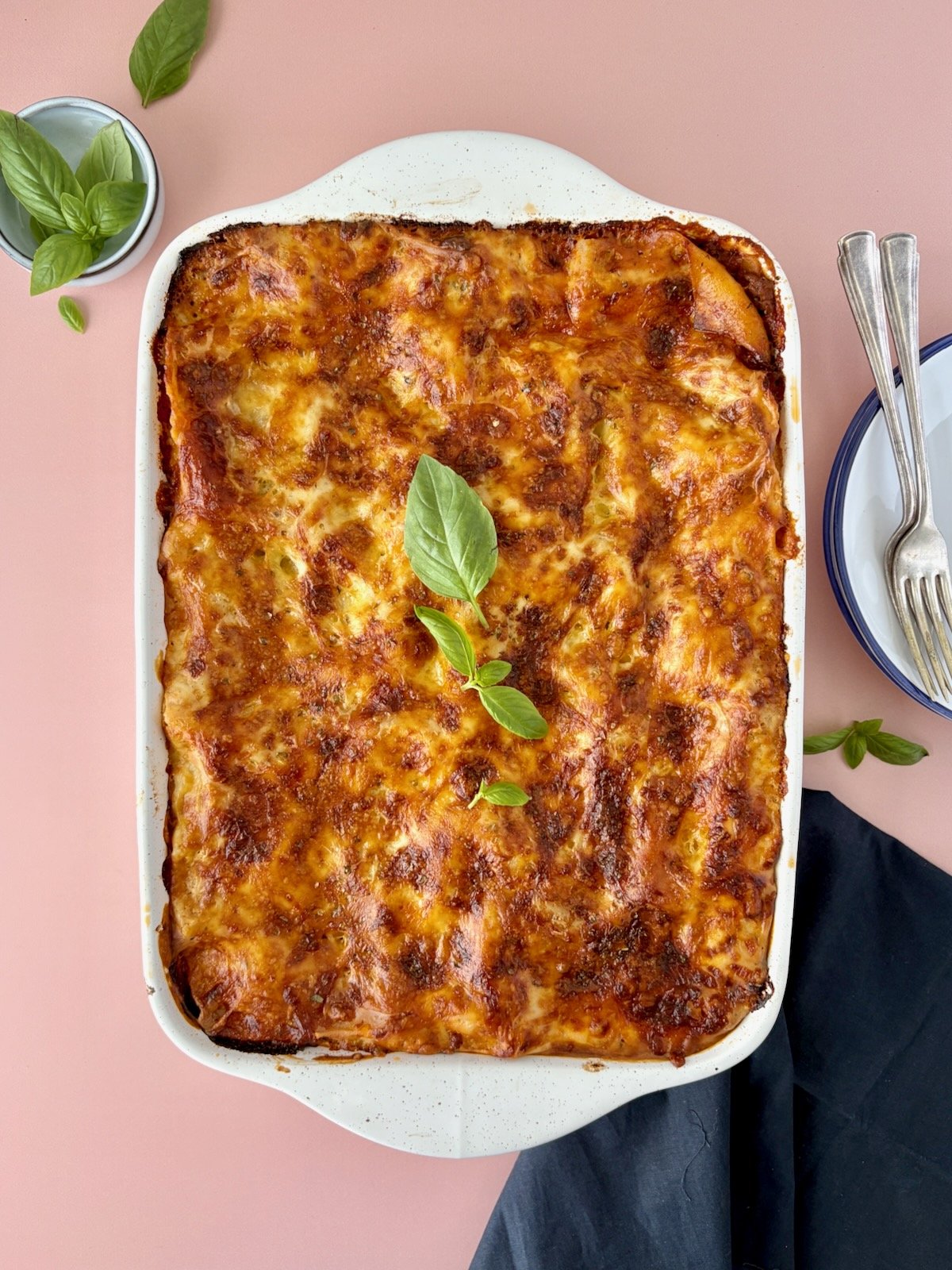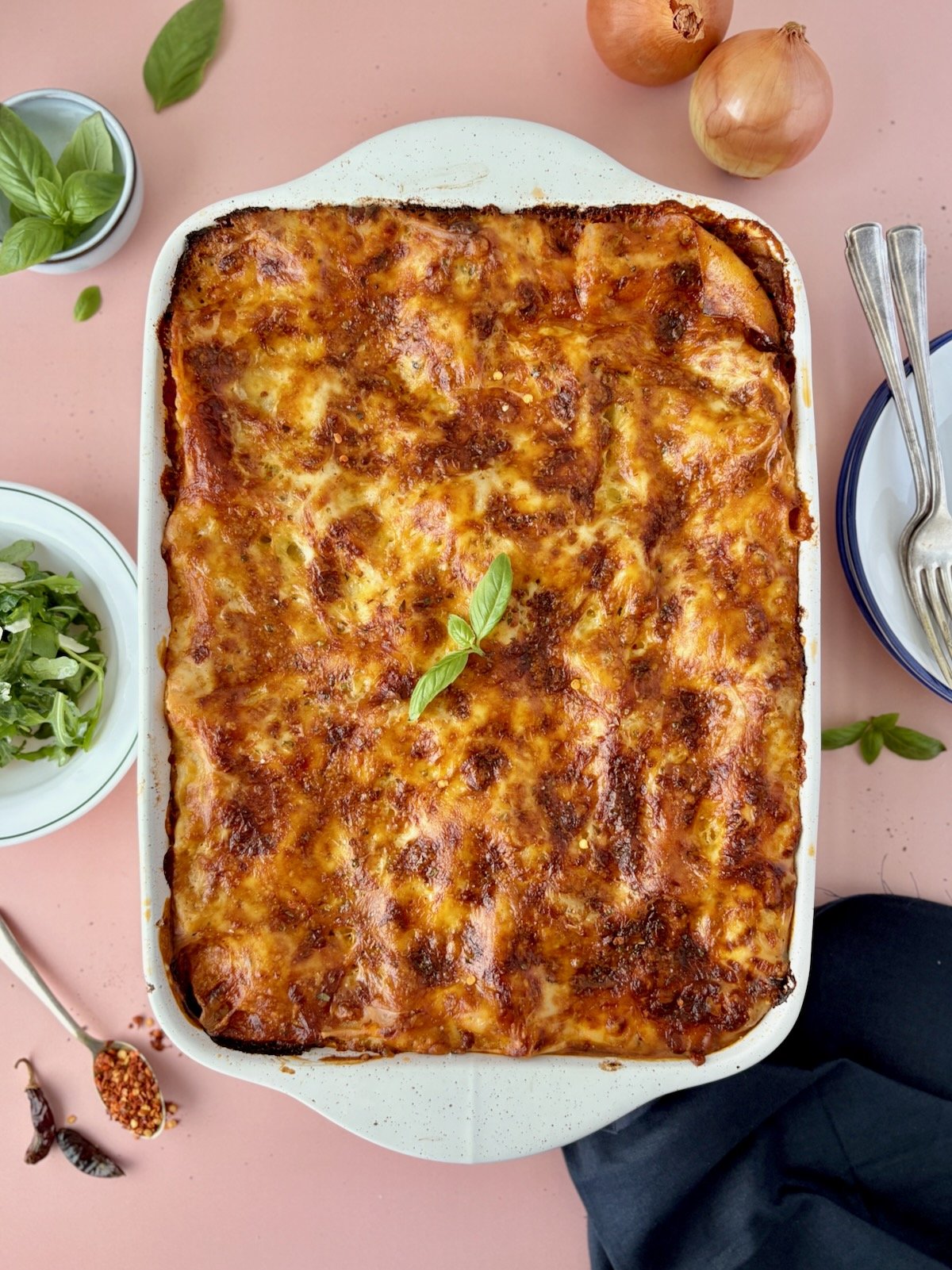Homemade Beef Lasagna with Hidden Veggies and Béchamel (DF & GF Options)
This homemade beef lasagna is packed with veggies and a rich, creamy béchamel sauce for the ultimate comforting meal. Plus, it’s meal-prep friendly and easy to customise with dairy-free and gluten-free swaps for a dish everyone can enjoy.
There’s nothing quite like a homemade lasagna — it’s cosy, nostalgic, and packed with flavour. This veggie-loaded beef version is one I come back to again and again, especially for meal prep. I often make a big batch and freeze half of the Bolognese sauce for a quick midweek spaghetti bolognese. Two homemade meals from one? Yes, please!
In This Post: Everything You Need For Homemade Beef Lasagna with Hidden Veggies and Béchamel
What Makes This Homemade Beef Lasagna with Veggies So Special?
This homemade beef lasagna stays true to the classic comforting flavours we all love but with a few tweaks to make it even better. It’s rich, hearty, and indulgent, while being veggie-loaded for a more balanced, nutrient-packed meal. Here’s what makes it special:
✔ Veggie-Loaded (Extra Nutrition) – Carrots, celery, mushrooms, and onion bring natural flavour, colour, and fiber to each layer—making the lasagna more nutritious.
✔ Stretches the Meat (Budget-Friendly!) – Bulking up the lasagna sauce with pantry-friendly vegetables means you can use less beef without sacrificing that hearty texture.
✔ Authentic Bolognese Technique – Simmering beef mince in milk before adding tomatoes tenderises the meat and creates a velvety, balanced sauce, enhancing the traditional Bolognese flavour.
✔ Rich and Creamy Béchamel – Instead of ricotta, this lasagna stays true to Italian tradition by using a smooth, creamy béchamel sauce, with a hint of nutmeg.
✔ Perfect for Meal Prep – This lasagna is great for meal prepping—it stores well, reheats beautifully, and can be frozen for easy, stress-free meals.
✔ Great for Picky Eaters – Finely diced veggies soften into the lasagna sauce, and blending them with the tomatoes before adding to the beef makes them virtually undetectable.
Why Add Milk to Beef Mince in Classic Bolognese? 3 Key Benefits
Milk is a secret ingredient in traditional Bolognese sauce and makes this homemade lasagna extra delicious. Here's why you should incorporate milk into your Bolognese sauce:
Tenderises the Meat – Milk contains lactic acid, which breaks down proteins in the beef, keeping it tender and juicy. This is a traditional step in Italian ragù alla Bolognese, whereby milk is added before tomatoes to soften the meat and enrich the sauce, ensuring an authentic, delicious texture in your Bolognese sauce.
Balances Acidity – Tomatoes can add acidity to Bolognese, but milk helps to neutralise this, adding a smooth sweetness and rich texture that balances the tangy tomato notes.
Adds Depth of Flavour – As the milk simmers into the sauce, it infuses the beef with a creamy richness, enhancing the overall flavour and creating a deeper, more complex sauce.
Which Veggies Work Best in a Veggie-Loaded Lasagna?
Homemade beef lasagna is the ultimate comfort food—and when you load it with veggies, it becomes even more nutritious and budget-friendly. This recipe uses classic vegetables like onion, carrot, and celery, but adding extra of these—along with field mushrooms—helps stretch the beef, boost flavour, and create a more balanced, nourishing meal.
Not only do the mushrooms help bulk up the sauce and stretch the beef, but their rich, meaty texture makes the lasagna feel hearty and satisfying—all while keeping it cost-effective. Want to add even more vegetables? Try incorporating grated zucchini and nutritious greens such as spinach or kale.
How to Make the Veggies Invisible (Kid-Friendly Tip!)
If you’re cooking for kids (or veggie skeptics), there are two easy techniques to make the vegetables virtually undetectable in your beef lasagna:
✔ Finely Dice – Finely dice the vegetables so they melt into the sauce as it cooks.
✔ Blend the Veggie Base – Sauté your vegetables, then blend with crushed tomatoes before adding to the cooked beef mince. This creates a smooth, velvety sauce packed with hidden veggies that even fussy eaters won’t notice.
A Spicy Bolognese Sauce: How to Adjust the Heat Level to Your Taste
This homemade beef lasagna features a subtle kick from dried chilli and chilli flakes, adding warmth and depth to the Bolognese sauce. Whether you crave bold heat or prefer a milder flavour, it’s easy to adjust the spice level to suit your taste and your families.
🌶 Zero-Mild: Omit the dried chilli and reduce or skip the chilli flakes. The Bolognese sauce will remain rich and full of flavour.
🌶🌶 Medium: Stick to the recipe as written for a gentle heat that enhances the savoury depth of the beef lasagna.
🌶🌶🌶 Spicy: Add an extra dried chilli, increase the chilli flakes to 2 tsp, or stir in a pinch of cayenne for an extra kick.
Is This Veggie-Loaded Beef Lasagna Healthy? How to Make It Healthier
This veggie-loaded beef lasagna stays true to its classic roots while adding extra veggies for more fiber and essential nutrients, but here’s how you can make it healthier:
Increase the Veggies – Add zucchini, capsicum, or spinach to the sauce for an extra boost of vitamins and nutrients.
Use Leaner Meat – Opt for lean beef mince or swap in chicken or turkey mince for a lighter, healthier lasagna. If you love trying different proteins in pasta dishes, try my Higher Protein Pasta Amatriciana, made with chicken mince for a leaner take on a classic Italian dish.
Swap the Pasta – Choose whole wheat or high-protein lasagna sheets to increase fibre and protein content.
Lighten the Béchamel – Mix ricotta with a splash of milk for a lighter, protein-packed version. Alternatively, swap the roux-based sauce for a creamy cauliflower sauce like this one from Pinch of Yum for a velvety, lower-fat option.
Reduce the Cheese – Use a moderate amount of cheese or choose a lower-fat variety for a lighter lasagna.
How to Make Homemade Beef Lasagna Gluten-Free
With a few simple substitutions, you can enjoy a delicious gluten-free version of this homemade beef lasagna without compromising on taste or texture.
Gluten-Free Pasta – Use gluten-free lasagna sheets, which are widely available in supermarkets. Ensure they are marked as certified gluten-free for the best results.
Béchamel Sauce – Swap plain flour for a gluten-free flour blend, cornstarch, or rice flour to thicken your sauce. Adjust the quantities as needed to achieve the desired consistency.
Stock & Beef Cubes – Make sure your stock and beef cubes are gluten-free or opt for homemade stock to avoid any hidden gluten ingredients.
Check Labels – Always check labels on items like tomato paste, spice mixes, and pre-shredded cheeses to ensure they are gluten-free.
How to Make Homemade Beef Lasagna Dairy-Free
Transform this homemade beef lasagna into a hearty and satisfying dairy-free version with a few simple swaps. You’ll enjoy all the rich, creamy goodness without the dairy – perfect for those with dairy intolerances and anyone looking for a healthier version of this classic comfort dish!
Dairy-Free Bolognese Sauce
Omit the Milk – Traditional bolognese uses milk to tenderise the beef and balance acidity. For a dairy-free alternative, simply omit the milk or replace it with vegetable stock for added depth.
Dairy-Free Béchamel Sauce
Butter Substitute – Swap dairy butter for plant-based butter or margarine to make it vegan-friendly.
Milk Substitute – Replace cow's milk with almond, oat, or soy milk (unsweetened) for a smooth, creamy consistency.
Cheese Alternative – Add dairy-free shredded cheese or nutritional yeast to give your béchamel a rich, cheesy flavour.
Dairy-Free Lasagna Cheese Layer
Plant-Based Cheese – Use a blend of mozzarella-style and cheddar-style plant-based cheese for a melty, satisfying texture.
Cashew-Based Vegan Cheese – For a creamy, ricotta-like layer, blend soaked cashews with nutritional yeast, lemon juice, garlic, and salt.
Nutritional Yeast – Sprinkle on top for an additional cheesy flavour boost.
Want a comforting dairy-free pasta without needing substitutions? Try my Dairy-Free Coconut Cream Carbonara for an easy, creamy alternative.
What to Serve with Homemade Beef Lasagna for a Complete Meal
To turn your classic beef lasagna into a well-rounded meal, pair it with vibrant, fresh sides that balance out the richness of the lasagna. Here are a few suggestions to complement the flavours and add variety:
Fresh Salad – A light, zesty salad is the perfect way to cut through the richness of lasagna. Try a simple rocket (arugula) salad, which offers a peppery bite and a burst of freshness. Top with shaved Parmesan for added flavour and texture.
Garlic Bread – No lasagna meal is complete without garlic bread. Whether you go for traditional or gluten-free, it’s the perfect crispy, buttery side to mop up the sauce and provide a satisfying crunch.
Steamed Greens – For a lighter, healthier option, steamed vegetables like broccoli, green beans, or spinach are a great way to add nutrients and contrast the richness of the lasagna.
Meal Prep-Friendly Beef Lasagna: How to Store and Reheat for Easy Meals.
This homemade beef lasagna is the ultimate meal prep dish, it stores, reheats, and holds up beautifully, making it perfect for easy meals or large batches to enjoy over several days. Here’s how to make the most of your veggie-loaded beef lasagna for stress-free meal prep:
Storing Lasagna
Refrigerating: Allow the lasagna to cool completely before storing. Once cooled, cover tightly with foil and refrigerate for up to 3–4 days. It makes for a quick and easy weeknight meal.
Freezing Lasagna: Lasagna freezes well for meal prep. After cooling completely, slice into individual portions and store in an airtight container. It will stay fresh in the freezer for up to 3 months—just make sure to label and date it for easy identification.
Reheating Lasagna
From the Fridge: Preheat your oven to 180°C (350°F). Place the lasagna on a baking tray, cover with foil, and bake for 20–25 minutes until heated through.
From the Freezer: If reheating from frozen, it’s best to defrost overnight in the fridge. Once defrosted, follow the same instructions as from the fridge. If you’re in a rush, you can bake directly from frozen—just increase the baking time to 45–50 minutes, covered with foil.
For Individual Serves: If you’re short on time, you can easily reheat individual servings in the microwave. Heat for about 2–3 minutes, then finish off in the air fryer for 3–5 minutes at 180°C (350°F) for a crispy, satisfying finish.
💡Top Tip for Easy Meal-Prep: For added convenience, double the bolognese sauce and freeze half. This lets you enjoy a second meal, like quick and easy spaghetti bolognese, later in the week. It's a great way to make the most of your meal prep!
Homemade Beef Lasagna with Hidden Veggies and Béchamel (DF & GF Options)
Servings: 8 | Prep: 40 mins | Cook Time: 1hr 45mins
Ingredients
For the Bolognese Sauce
1 white onion, finely diced
2 large carrots, peeled and finely diced
3-4 celery stems, leaves removed and finely diced
4 large field mushrooms, finely diced
2 beef stock cubes
½ cup milk
½ cup tomato paste
800g tinned tomatoes, crushed
1 tsp brown sugar
500g beef mince
2 tbsp olive oil, extra virgin
Spices for the Bolognese Sauce
1 tsp each sea salt and black pepper
1½ tsp each basil, oregano, thyme, rosemary, dried
2 heaped tsp garlic, minced
2 bay leaves, dried
1 dried chilli, broken in half
1 tsp chilli flakes (or to taste)
For the Béchamel sauce
80g (⅓ cup) butter, unsalted
80g (⅔ cup) plain flour
800ml (3½ cups) milk
½ tsp sea salt
1 tsp black pepper, freshly ground
½ tsp nutmeg, ground
For the Lasagna
500g pasta sheets, dried
2 cups cheese, shredded (equal mix of tasty and mozzarella)
Method
Bolognese Sauce:
Heat a large pan over medium heat. Add olive oil, then sauté the onion for 2–3 minutes until softened.
Add the diced carrot and celery. Sauté for 3–4 minutes until they begin to soften.
Stir in the mushrooms and cook until they reduce to half their size. Transfer the vegetables to a bowl and set aside.
In the same pan, add a little more oil if needed, then add the beef mince. Cook, breaking it apart, until browned.
Add the crushed beef stock cubes, minced garlic, and milk. Stir well and bring to a gentle boil, cooking for 1–2 minutes to allow the milk to absorb.
Return the sautéed vegetables to the pan and mix well.
Stir in the tomato paste, crushed tomatoes, brown sugar, and all the spices. Mix thoroughly.
Reduce heat to low and simmer uncovered for 60 minutes, stirring occasionally, until the sauce thickens and deepens in flavour. Remove the bay leaves before assembling the lasagna. (You can continue to cook this bolognese longer to deepen the flavour, I usually let it simmer for 1-2 hours until I’m ready to assemble the lasagna)
Important: Remove the bay leaves and dried chilli halves before assembling the lasagna.
Béchamel Sauce:
In a saucepan over medium heat, melt the butter. Once melted, add the flour and whisk continuously for 1–2 minutes to cook out the raw flour taste.
Gradually pour in the milk, whisking constantly to prevent lumps.
Continue stirring until the milk heats up and the sauce thickens, reaching a smooth, creamy consistency.
Season with salt, pepper, and nutmeg. Remove from heat and set aside.
Assembling the Lasagna:
Preheat the oven to 180°C (350°F).
In a large 12x9 inch baking dish, spread a thin layer of Bolognese sauce at the bottom.
Place a layer of pasta sheets over the sauce, slightly overlapping them.
Spread 2–3 ladles of Bolognese sauce evenly over the pasta, followed by 2 ladles of Béchamel sauce. Sprinkle with ¼–½ cup of cheese.
Repeat the layering process: pasta → Bolognese → Béchamel → cheese, until all ingredients are used. (Depending on your dish, you should get 3-4 layers. If your dish is quite full after layering, I recommend placing it on a baking tray before transferring it to the oven to catch any spills and ensure easy cleanup.)
Cover loosely with foil and bake for 30 minutes. Remove the foil and bake for another 10-15 minutes, until the top is golden and bubbling.
Let the lasagna rest for 10–15 minutes before slicing and serving.
Frequently Asked Questions
-
Yes! This veggie-loaded beef lasagna is perfect for meal prep. You can assemble it a day in advance and refrigerate it before cooking. Just make sure keep it covered to maintain freshness.
-
This recipe uses classic vegetables like onions, carrots, celery, and mushrooms. You can also add zucchini, spinach, or any other veggies you like. The key is to chop them small to blend seamlessly into the sauce.
-
Absolutely! While this recipe uses beef mince, you can substitute it with pork, ground turkey, chicken, or even a plant-based mince for a vegetarian version.
-
I recommend reducing the spice by omitting the dired chilli and chilli flakes.
To make the veggies virtually invisible for picky eaters, finely dice or blend the vegetables into the sauce. This will help the lasagna maintain its rich, hearty taste while sneaking in extra nutrition.
-
I wouldn’t consider this lasagna healthy, but it is packed with nutrients and fiber from the vegetables. If you'd like to make it even healthier, consider trying my tips here.
-
For a gluten-free version, swap the regular lasagna sheets with gluten-free ones and replace the flour in the béchamel. Read more here.
-
To make it dairy-free, use dairy-free cheese and opt for a plant-based milk and butter the sauce. Read more here.
-
For a complete meal, serve your lasagna with a fresh salad (I love a balsamic dressing), garlic bread, or roasted veg. A simple side of steamed greens also pairs beautifully with this hearty dish.
-
Store any leftover lasagna in an airtight container in the fridge for up to 3-4 days. To reheat, simply microwave individual portions or warm the whole dish in the oven at 180°C (350°F) for 20-25 minutes. Read more here.














